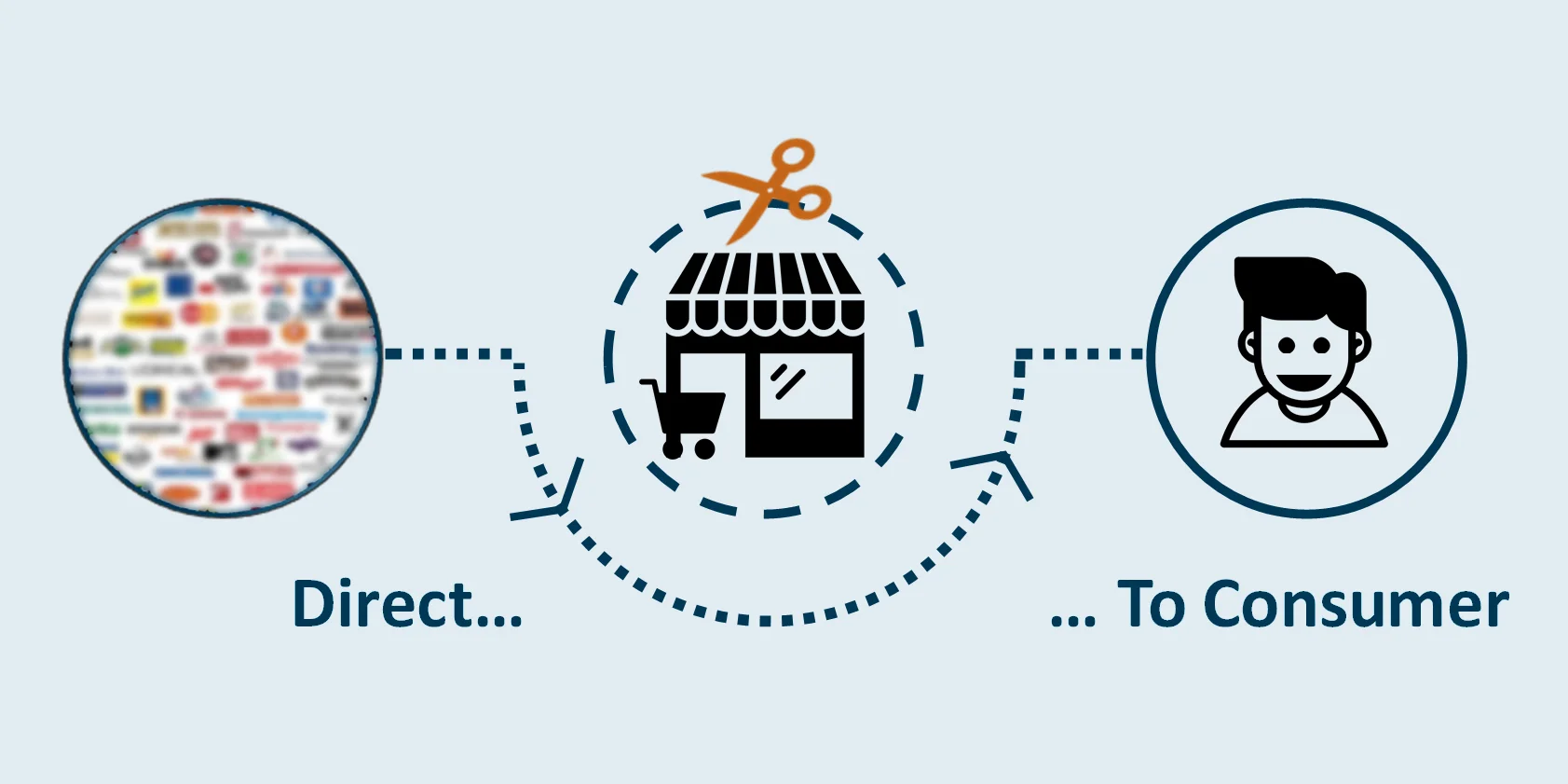Table of Contents
Today clients have high expectations regarding the brands they communicate with and expect a positive shopping experience. So many leading companies are responding to such expectations by taking their offerings directly to buyers.
Known as DTC (direct-to-consumer, D2C), digital platforms have enabled closer, more direct relationships between each company and its shoppers, resulting in what is most usually a more positive and convenient shopping experience.
The perks of adopting a DTC approach are multiple. Using a DTC strategy in your sales and marketing, you can better differentiate yourself and your products within the market. It also allows companies to develop better relationships with their clients, which builds loyalty.
This article will explain what direct-to-consumer is, go deeper into how it is beneficial and show how you can leverage DTC to foster stronger bonds with your target audiences.
DTC Meaning in eCommerce

Direct-to-consumer (DTC, D2C) is when a manufacturer or brand offers its merchandise to its end clients. The D2C retail approach involves selling goods without the help of third-party retailers or wholesalers.
The D2C retail strategy is defined by the following:
- DTC companies manage their product inventory levels. When clients place orders, the brand is responsible for sorting, picking, and delivering the item.
- You don’t need to depend on third-party services to buy or deliver the products.
- DTC companies communicate with clients directly and are in charge of fulfillment.
The DTC model grows in popularity as it brings companies closer to shoppers. DTC businesses directly interact with clients, strengthening their relationships. By going DTC, brands can also better understand who is buying their goods and why.
DTC eliminates a few steps of the purchasing cycle and often delivers a more efficient client experience. 67% of online customers have bought directly from brands within the last three months.
In addition, according to eMarketer’s research, DTC eCommerce sales in the United States will exceed $151.2 billion in 2022, a growth of 16.9% compared to last year.
Benefits of the Direct-to-Consumer Approach
Small and large companies cannot ignore what making their shop can do for them. Below are some benefits a direct-to-consumer selling approach can bring to your brand.
The D2C strategy lets companies build a real connection with consumers.
When offering products directly to your end client, you can tell your company’s story directly to them. Usually, if your product was chosen over other sellers on a retailer’s platform, you might have won the sale, but did you connect with that client?
D2C brands finally get data about customers.
Historically companies have sold to middlemen or retailers who maintained the relationships with their clients. It means all the precious information about shopping trends and demographics was unavailable to brands. In turn, with a client’s physical address or email, the company can deliver a more customized marketing experience.
Clients expect a better experience than they have historically faced.
Clients (especially younger ones) are becoming more used to positive digital experiences and expect their shopping to be seamless. If you sell to a middleman or retailer, you have no or very little control over interactions between them and buyers.
Instead, D2C brands can control all parts of consumers’ interactions with their products and business without intermediaries entering any part of the client journey. In addition, developing customer relationships brings better customer loyalty, an essential factor for every brand.
Tip: sellers can use third-party software, like SageMailer, to grow reviews and enhance their reputation.

Such tools connect with Amazon API, allowing merchants to send customized review requests using Buyer-Seller Messaging templates and automating Amazon’s “Request a Review” button requests. It will save tons of your valuable time, help you get more Amazon ratings and reviews, and improve your performance on the platform.
Companies can enhance new product launches.
One of the most complex parts of being a brand is creating goods your target demographic will buy low. If you do not have a direct communication line with your client, how efficient can you become at new merchandise rollouts?
How to Get Started with DTC Sales?
Nowadays, direct-to-consumer companies account for 40% of the increase in the eCommerce market, and that number only grows yearly. As a result, it is easier than ever to launch a D2C brand, but where to start?
Step 1: Narrow in on your niche
Obviously, you need some merchandise to sell, and it is always simpler to start with one or a limited set of items. You will want to conduct a lot of product research to learn what is already on the market, what other sellers are doing, and what the pricing range is. Is there one main player in this category? Is the niche segmented into high, mid-range, and low price points with the appropriate quality? The clear you can stay about what you wish to offer, the better.
After picking your product or product line, we recommend narrowing your niche. So, you can definitely stand out from other sellers from the get-go. For instance, will you focus on being eco-friendly? Interestingly, 46% of buyers are more likely to purchase an item if it is eco-friendly. Choose what niche your item can fit into and develop your business.
It is also when you wish to decide on dropshipping or handling the entire supply chain yourself. The first option is easy to get started. However, it leads to tougher competition and difficulties differentiating on the Amazon platform. At the same time, managing your supply chain yourself allows you to stand out. Yet, it takes more effort, time, and investments to get off the ground.
Step 2: Choose your channels
The second is more complicated than it sounds, as it does not necessarily indicate your most comfortable channels. It may sound tempting to try all the channels and check what works. Nevertheless, that is a quick way to stretch yourself too thin and end up not doing well on any channels.
Begin with researching social media statistics so that you can narrow down your target demographics and what platform they use the most. If you are gunning after a young audience, your main social media channels should be Tik Tok and Instagram. For female millennials, go to Pinterest and Instagram. Wherever you think your clients will be, follow them there.
Step 3: Select your selling platform
Now you need to pick an avenue to sell your products. You can try choosing multiple, but at the beginning, it is recommended to stick to one and scale later when you feel like it’s essential. So when you face this decision, you can go two main paths: setting up a profile on a third-party selling marketplace, like Amazon, or making a storefront on a platform like Shopify.
Creating an account on a third-party marketplace can seem like the path of least resistance. It is often free or cheap to sign up with less effort. Besides, the audience is built-in, so the platform takes a small fee on each sale. Amazon is the most popular of such platforms, and it’s the top place customers search for products to buy.
Step 4: Establish your sales and marketing plan
Whether selling on an existing platform or bringing traffic to your site, you need a plan to promote your goods and generate sales. Based on your merchandise niche, there will be some techniques that make sense and some that do not. Let’s take a look at some of them:
- Social media. When you are driving all the traffic to your website, social media advertising is a must. Focus on creating informative, promotional content to attract potential customers.
- Influencer campaigns. As part of the general social media strategy, working with influencers may have huge ROIs if done properly. Start with compiling a list of bloggers in your niche and asking them to make sponsored posts and stories or just sending them free items in the hopes that they share your brand with their followers.
- Social media selling. Apart from marketing via social media, you may set up a store on the platforms that have such a feature. Facebook Shop has been around for a while, Instagram is stepping up its shopping game, and even Pinterest is going to carve out a piece of the pie.
- In-platform advertisements. Whichever platform you end up on, they are likely to have its built-in internal advertising system. Instagram Ads, Facebook Ads, or Etsy Ads are all solutions to grow your reach on the avenues you have chosen to sell on.
- Email newsletter. There is no better client than a returning client, and an email newsletter is an effective way to keep in touch and get them back in.
- In-person events. Trying to go hyperlocal? Start exploring event opportunities in your local communities to build close relationships.
Step 5: Set up your fulfillment process
Oh yeah – and as soon as you go to all those tasks to start getting purchases rolling in, you will actually need to handle those orders! And refunds, even though nobody wants to think about it. As a new brand, you will likely be handling those orders from your cabinet or garage, but you may think about other options when you can scale.
Your first solution is renting a space and hiring staff to manage fulfillment. You will retain complete control over this process, but it comes with its downsides. Not only can it be expensive, you likely are not a fulfillment expert, and you might not be located in a convenient area for fast delivery across the country.
Amazon FBA or third-party fulfillment providers are an excellent option for when you outgrow the garage and want to outsource this part of the business. They cost more upfront and tend to require some order minimum per month, but they provide better reach, faster delivery times, lower shipping costs, and time spared for you to concentrate on other aspects of your business.
Direct-to-Consumer: Final Thoughts
With clients’ shopping habits changing rapidly, there has never been a better time for companies to consider using DTC for a new era. Whether selling directly to clients via an established marketplace or application or by setting up an online offering through web channels, a business’s ability to communicate directly with its clients can help enhance brand perception and elevate loyalty in new and untapped markets. Thus, DTC provides an effective way to broaden your offline and online connections with clients.
Learn more about how SageMailer can help your online business deliver a top-notch customer experience anytime. Ready to start now? Try the software free for 30 days; no credit card is needed.

